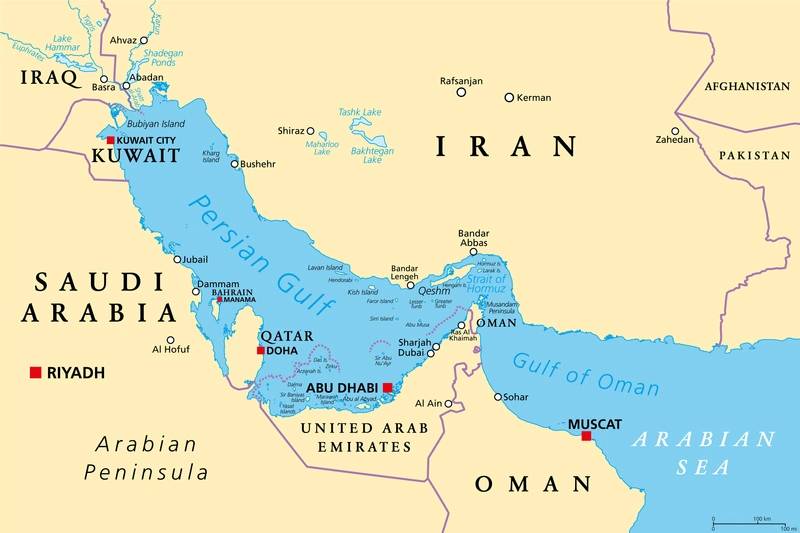Strait of Hormuz: The World's Most Important Oil Artery
The Israel-Hamas war has raised the spectre of a wider regional conflict which could embroil Iran and other regional factions.
Analysts and market observers say the conflict could prompt the United States to tighten sanctions on Iran, which may spur Tehran to take retaliatory action against ships in the Strait in Hormuz.
The Marshall Islands registry, one of the world's top shipping flags, last week flagged that vessels with links to Israel or the United States may face a heightened threat of attack within Israeli territorial waters, the Mideast Gulf, Strait of Hormuz, Gulf of Oman and Red Sea areas.
Below are details about the Strait:
WHAT IS THE STRAIT OF HORMUZ?
The strait lies between Oman and Iran.
It links the Gulf north of it with the Gulf of Oman to the south and the Arabian Sea beyond.
It is 21 miles (33 km) wide at its narrowest point, with the shipping lane just two miles (three km) wide in either direction.
The United Arab Emirates and Saudi Arabia have sought to find other routes to bypass the Strait, including building more oil pipelines.
 © Peter Hermes Furian / Adobe Stock
© Peter Hermes Furian / Adobe Stock
WHY DOES IT MATTER?
About a fifth of the volume of the world's total oil consumption passes through the Strait on a daily basis. An average of 20.5 million barrels per day (bpd) of crude oil, condensate and oil products passed through Hormuz in January-September 2023, data from analytics firm Vortexa showed.
OPEC members Saudi Arabia, Iran, the UAE, Kuwait and Iraq export most of their crude via the Strait.
Qatar, the world's biggest liquefied natural gas (LNG) exporter, sends almost all of its LNG through the Strait.
Some 80 million metric tons, or 20% of global LNG flows go through the Strait every year, Vortexa said.
"If the conflict broadens to include the closure of the Strait of Hormuz —the world's busiest oil-shipping channel— it would shut down the region's oil trade, supercharging oil prices," JP Morgan said in a note this week.
"Crucially, while Iran has threatened over the years to block the strait, it had never followed through," the bank added.
IMPACT OF U.S. SANCTIONS
The United States has imposed sanctions on Iran aimed at halting its oil exports.
Iran has threatened to disrupt oil shipments through the Strait of Hormuz if the United States tries to strangle its economy.
The U.S. Fifth Fleet, based in Bahrain, is tasked with protecting commercial shipping in the area.
RISING TENSIONS
The Israeli army is readying for a ground invasion with the aim of annihilating Hamas, raising the risk of a wider conflict.
Iranian Foreign Minister Hossein Amirabdollahian on Oct. 18 called on Muslim countries to impose an oil embargo and other sanctions on Israel, but OPEC sources dismissed such a scenario.
In 1973, Arab producers led by Saudi Arabia slapped an oil embargo on Western supporters of Israel in its war with Egypt, targeting Canada, Japan, the Netherlands, Britain and the United States.
While Western countries were the main buyers of crude produced by the Arab countries at the time, nowadays Asia is the main buyer of OPEC's crude.
PAST INCIDENTS
During the 1980-1988 Iran-Iraq war, the two sides sought to disrupt each other's oil exports in what was known as the Tanker War.
In July 1988, the U.S. warship Vincennes shot down an Iranian airliner, killing all 290 aboard, in what Washington said was an accident and Tehran said was a deliberate attack.
In early 2008, the United States said Iranian vessels threatened three U.S. Navy ships in the Strait.
In July 2010, Japanese oil tanker M Star was attacked in the Strait by a militant group called Abdullah Azzam Brigades linked to al Qaeda claiming responsibility.
In January 2012, Iran threatened to block the Strait in retaliation for U.S. and European sanctions that targeted its oil revenue in an attempt to stop Tehran's nuclear programme.
In May 2015, Iranian ships seized a container ship in the Strait and fired shots at a Singapore-flagged tanker which it said had damaged an Iranian oil platform.
In July 2018, President Hassan Rouhani hinted Iran could disrupt oil trade through the Strait in response to U.S. calls to reduce Iran's oil exports to zero.
In May 2019, four vessels - including two Saudi oil tankers - were attacked off the UAE coast near Fujairah, one of the world's largest bunkering hubs, just outside the Strait of Hormuz.
In January 2021, Iran seized a South Korean-flagged tanker in Gulf waters and detained its crew.
In December 2022, the U.S. military said that an Islamic Revolutionary Guard Corps Navy boat came within 150 yards of American warships in the Strait.
In May 2023, Iran seized two oil tankers while passing through the Strait.
In July 2023, the U.S. Navy said it had intervened to prevent Iran from seizing two commercial tankers in the Gulf of Oman. A Navy statement said that since 2021, Iran had "harassed, attacked or seized nearly 20 internationally flagged merchant vessels".
(Reuters - Reporting by Ahmad Ghaddar; Editing by Susan Fenton)











